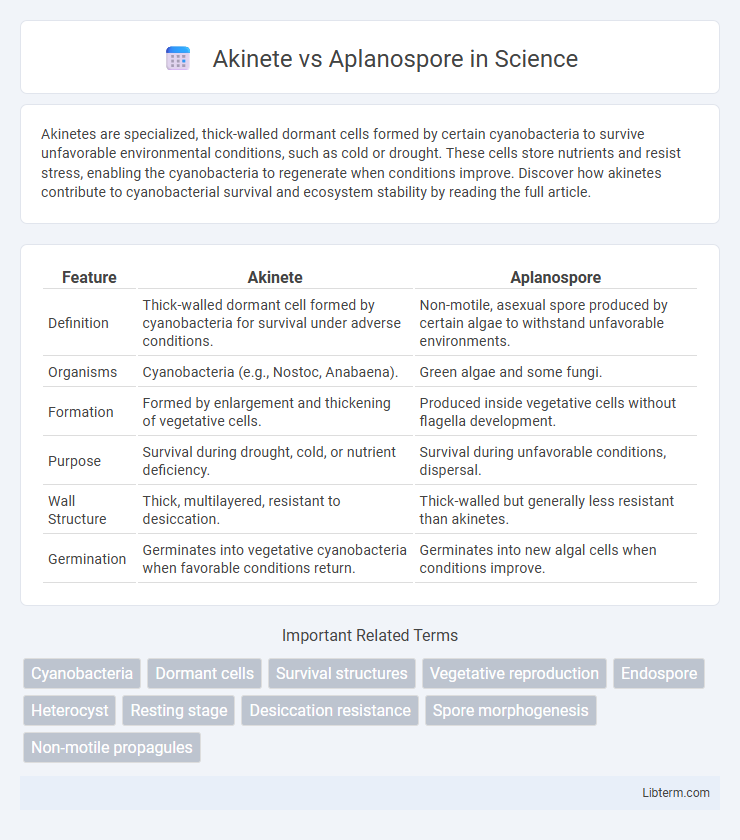Akinetes are specialized, thick-walled dormant cells formed by certain cyanobacteria to survive unfavorable environmental conditions, such as cold or drought. These cells store nutrients and resist stress, enabling the cyanobacteria to regenerate when conditions improve. Discover how akinetes contribute to cyanobacterial survival and ecosystem stability by reading the full article.
Table of Comparison
| Feature | Akinete | Aplanospore |
|---|---|---|
| Definition | Thick-walled dormant cell formed by cyanobacteria for survival under adverse conditions. | Non-motile, asexual spore produced by certain algae to withstand unfavorable environments. |
| Organisms | Cyanobacteria (e.g., Nostoc, Anabaena). | Green algae and some fungi. |
| Formation | Formed by enlargement and thickening of vegetative cells. | Produced inside vegetative cells without flagella development. |
| Purpose | Survival during drought, cold, or nutrient deficiency. | Survival during unfavorable conditions, dispersal. |
| Wall Structure | Thick, multilayered, resistant to desiccation. | Thick-walled but generally less resistant than akinetes. |
| Germination | Germinates into vegetative cyanobacteria when favorable conditions return. | Germinates into new algal cells when conditions improve. |
Introduction to Akinetes and Aplanospores
Akinetes are thick-walled dormant cells formed by cyanobacteria as survival structures under adverse environmental conditions, characterized by their large size and high nutrient content. Aplanospores are non-motile, asexual spores produced by certain algae and fungi, serving as a means of reproduction and dispersal without flagella. Both akinetes and aplanospores contribute to the persistence and propagation of their respective organisms through unfavorable periods.
Definitions and Basic Characteristics
Akinetes are thick-walled, dormant cells formed by filamentous cyanobacteria, serving as survival structures during unfavorable environmental conditions by storing nutrients and enhancing resistance. Aplanospores are non-motile, asexual spores produced by certain algae and fungi, designed primarily for reproduction and dispersal without flagella. Both structures aid in survival and propagation, but akinetes emphasize endurance under stress, while aplanospores focus on reproduction and colonization.
Formation Process of Akinetes
Akinetes form through the enlargement and thickening of vegetative cells in cyanobacteria, accumulating nutrient reserves like glycogen and cyanophycin for survival under adverse conditions. This differentiation process involves changes in cellular morphology and metabolic activity, enhancing resistance to desiccation, cold, and nutrient scarcity. In contrast, aplanospores result from the internal development of motile or non-motile spores within a sporangium, primarily serving as dispersal units rather than survival structures.
Formation Process of Aplanospores
Aplanospores form through a process where vegetative cells undergo internal cytoplasmic division without developing flagella, resulting in non-motile spores enclosed within the parent cell wall. This contrasts with akinetes, which develop by thickening of the cell wall and accumulation of food reserves to survive unfavorable conditions. The formation of aplanospores involves reduction in metabolic activity and cytoplasmic reorganization, preparing them for dormancy and subsequent germination when conditions improve.
Structural Differences
Akinetes are thick-walled dormant cells with dense cytoplasm and numerous food reserves, enabling cyanobacteria to survive harsh conditions. Aplanospores are non-motile spores characterized by a thinner but smooth wall, formed within filamentous algae for asexual reproduction. Structurally, akinetes exhibit a robust protective envelope and granule accumulation, whereas aplanospores lack such dense storage inclusions and possess a simpler cell wall architecture.
Survival Strategies and Environmental Adaptations
Akinetes serve as thick-walled dormant cells formed by cyanobacteria to withstand harsh environmental conditions such as desiccation, cold, and nutrient depletion, enabling long-term survival. In contrast, aplanospores, found in certain algae and fungi, are non-motile spores adapted for rapid colonization when favorable conditions return but offer less resistance to extreme stress. Both structures represent distinct survival strategies optimizing persistence and proliferation in fluctuating aquatic and terrestrial ecosystems.
Ecological Roles and Significance
Akinetes serve as durable survival spores in cyanobacteria, enabling persistence through harsh environmental conditions such as desiccation, nutrient depletion, and temperature extremes, thus ensuring the continuity of cyanobacterial populations. Aplanospores function as non-motile asexual spores in fungi and algae, facilitating dispersal and colonization primarily in stable or nutrient-rich habitats without the requirement for motility. Both structures contribute significantly to ecological dynamics by promoting species survival, reproduction, and population stability in their respective ecosystems.
Occurrence in Algae and Cyanobacteria
Akinetes occur predominantly in cyanobacteria, serving as thick-walled dormant cells that ensure survival during adverse conditions; they are absent in algae. Aplanospores, found mainly in certain green algae, are non-motile spores formed within the parent cell for asexual reproduction. The distinct presence of akinetes in cyanobacteria and aplanospores in algae highlights their specialized roles in survival and propagation across these organisms.
Comparison Table: Akinete vs Aplanospore
Akinetes are thick-walled dormant cells formed by cyanobacteria as a survival strategy under unfavorable conditions, whereas aplanospores are non-motile spores produced by certain algae for asexual reproduction. Akinetes exhibit resistance to desiccation and cold, measuring typically 10-50 um, while aplanospores tend to be smaller and primarily function to disperse the organism without dormancy capabilities. Both structures lack flagella, but akinetes serve as resting spores with nutrient storage, contrasting with the reproductive role of aplanospores.
Conclusion and Future Research Directions
Akinetes and aplanospores serve as vital survival structures in cyanobacteria and algae, with akinetes providing enhanced resistance to desiccation and cold, while aplanospores enable dispersal through non-motile spores. Understanding the molecular mechanisms and environmental triggers governing their formation remains limited, necessitating advanced genomic and proteomic studies. Future research should focus on deciphering signaling pathways and genetic regulation to exploit these structures in biotechnology and ecosystem management.
Akinete Infographic

 libterm.com
libterm.com